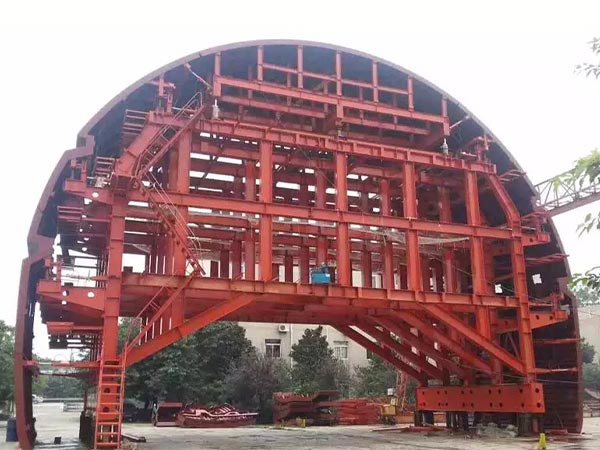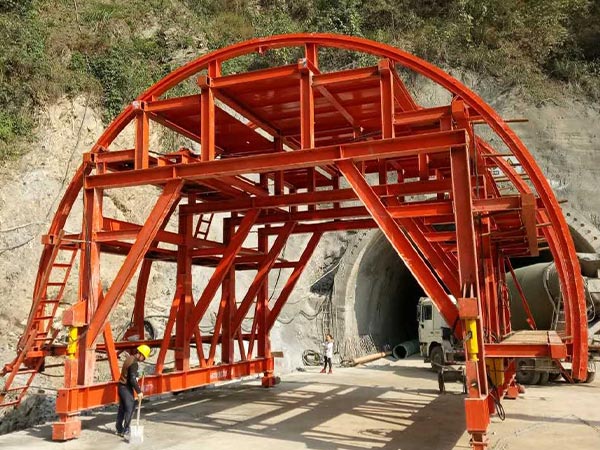Construction technology of special grouting machine with mould for tunnel lining
Tunnel lining special grouting machine vault with mold grouting construction technology is to open a hole on the top of the lining trolley, and then set the RPC grouting pipe on the vault. After the lining is finished, the grouting integrated machine with mold High pressure injects micro-expansion mortar to treat vault voids, ensure the thickness of tunnel lining, and prevent tunnel lining vaults from voiding.
Technical advantages of special grouting machine for tunnel lining
1. By simplifying the embedded pipe and grouting construction technology, improving the grouting tooling and repairing grouting binder, the hidden project of the lining vault pouring is transformed into a “visible” project to prevent the defects of the lining vault; adopt micro-expansion grouting The grout binder has defects such as repairing construction gap joints, cold joints and imperfect concrete.
2. Through the penetration of the slurry, the damage of the waterproof board is blocked, forming a “mushroom” type plug, which has a water blocking function.
3. The tunnel lining special grouting machine is used for grouting. The equipment integrates the functions of slurry preparation, storage and grouting, and has a high grouting pressure, which can fully overcome the pipeline resistance and the low water-to-material ratio slurry. The resistance to vertical conveyance of the slurry.
4. Utilize the support of the lining trolley, adopt higher grouting pressure, and implement low water-to-material ratio grouting, which is fully dense, safe and reliable.
5. Use the special grouting machine for tunnel lining to grouting. The equipment is small in size and does not occupy space. In addition, the lining construction gap grouting does not affect other processes.
The principle of grouting with mold for tunnel lining
Through the transformation of the lining trolley, a certain number of grouting holes are set along the longitudinal direction of the trolley at the center line of the lining trolley formwork, and fixed flanges for grouting are installed, and the reactive powder concrete (RPC) is embedded before the concrete is poured. Grouting pipe, grouting from the embedded grouting pipe in time after concrete pouring.

The characteristics of the grouting process of the tunnel lining with a mold
1. By simplifying the pre-embedded pipe and grouting construction process, improving the grouting tooling and the lining micro-expansion grouting binder, the concealed project of the lining vault pouring is transformed into a “visible” project, preventing the defects of the lining vault and avoiding lining If the thickness is insufficient, carry out secondary backfill grouting or destroy and rebuild.
2. The micro-expansion grouting binder has the function of repairing construction gaps, cold joints, and concrete imperfections, lack of edges and corners, etc.; through the penetration of the slurry, the damage of the waterproof board is blocked, forming a “mushroom” type plug, which has water blocking Function to reduce leakage at the top of the arch.
3. Special grouting machine for tunnel lining is used for grouting. This equipment integrates grouting, grouting, and grouting as a whole, and has a high grouting pressure, which can fully overcome the pipeline resistance and the low water-to-material ratio slurry. The resistance to vertical conveyance of the slurry.
4. With the support of the lining trolley, grouting is done in time after the concrete is poured. The construction period does not affect other processes.
5. Count the lining grouting volume of each ring, implement process management and assessment, and force the construction team to improve the quality of lining grouting.
The key points of the construction of tunnel lining with mold grouting

Generally, 1 to 2 hours after the completion of concrete pouring, grouting with a mold is started.
1. Grouting process
Carry out grouting to the main grouting hole #1, and control the water-to-material mass ratio to 0.18. Stop grouting when the grouting hole of the #2 grouting hole or the reading of the pressure gauge exceeds 1.0MPa, and inject 2# and 3# in sequence. The grout hole is grouted, and the grouting is finished when the grout comes out from the end mold of the secondary lining. The 4# grouting hole is a spare, which can be selected according to the grouting situation.
2. Key points of grouting
① The grouting sequence is from the main grouting hole to the end mold grouting hole.
② Each grouting hole needs to be grouted, but when the grouting hole of other holes is grouted during the grouting process, when the grouting hole reaches the same density, the hole can be closed without grouting.
③ The end of grouting marks the end of grouting when the thick grouting out of the exhaust hole and end template. If the grout pressure at the trolley template reaches 1.0MPa and no thick grout is produced, the grout hole should be replaced for grouting until the end mold exhaust hole flows out of the thick grout. The RPC grouting pipe must be full, and the RPC grouting pipe should be sealed in time when the grouting connector is replaced after the grouting is completed.
④ Record the total amount of grouting, the start time and end time of grouting.
3. Pipeline cleaning
After the grouting is finished, close the grouting valve, remove the hose and grouting pipe fittings of the grouting machine, block the RPC grouting pipe in time, and rinse the grouting equipment repeatedly with clean water to ensure the smooth flow of the pipeline. After the strength of the lining concrete reaches 8.0MPa, knock out the RPC grouting pipe, and the trolley will be demoulded and enter the next cycle construction process.

Precautions for the operation of grouting with mold
1. Before the concrete is poured, analyze the embedded length of the grouting pipe, and basically judge the flatness of the lining and the condition of over-under-excavation through the length of 4 grouting pipes embedded in each cycle. Especially if the length of the embedded pipe is significantly smaller than the design thickness, it is necessary to exit the trolley, remove the waterproof board, and reprocess the support to avoid leaving hidden dangers.
2. During the concrete pouring process, observe the grouting condition of the grouting pipe. In principle, it is required that each grouting pipe can produce grout. In this case, it can ensure that the vault concrete is full, without quality defects, and the amount of grouting is small. In the case of uneven support, it should also be ensured that 1-2 grouting pipes are grouting, especially the remote grouting pipes.
3. After the concrete is poured, analyze the amount of grouting with mold in time. The amount of grouting per 12m lining vault is 0.5~1m3 (according to the grade of surrounding rock, the void volume is 0.5~1m3).
4. Under the condition that the support flatness meets the requirements, if the grouting material exceeds the normal dosage, the reason must be analyzed in time, and the next cycle lining concrete mix ratio and pouring process must be adjusted to improve the lining concrete pouring quality.
5. Due to uneven support, the end template is easy to leak. If the end template leaks at a low position, it is easy to fail to maintain pressure and the vault is full. Therefore, the end template should be closed, such as placing an arc to prevent leakage. Waterproof board or waterproof cloth, etc.













